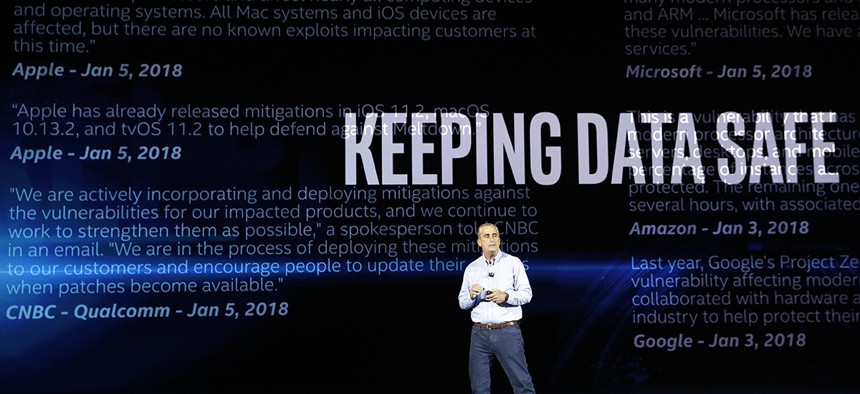How Long Did the US Government Know about Spectre and Meltdown?

Intel CEO Brian Krzanich delivers a keynote speech at CES International Monday, Jan. 8, 2018, in Las Vegas. Jae C. Hong/AP
The largest CPU bug in history caught the Defense Department by surprise. Or not.
Did the Defense Information Systems Agency, or DISA, hide two of the largest computer flaws in history from the rest of the U.S. government? Or did they fudge how badly the vulnerabilities caught them by surprise?
On Jan. 2, the world learned that many CPUs manufactured by Intel expose supposedly-protected data through processes meant to speed up computing. Soon afterward, Defense One asked DISA officials how the Spectre and Meltdown vulnerabilities were affecting the tens of thousands of Defense Department computers that contain the chips.
A spokesperson responded that the agency will “not comment on specific products, nor the tactics, techniques, and procedures in which they may be used as such information could be used to undermine the DoD’s information networks.”
But on Jan. 11, then-DISA chief Lt. Gen. Alan Lynn addressed how long his agency had known about the problem.
“I have to be careful about how much detail I get into in terms of how long. But we’ve known about it for a little while,” Lynn told an audience at an AFCEA event. “When there’s an incident, an issue on a network, we triage it…We ask, ‘how hard is it to actually get into the device’ and then decide how big of a problem that is for us. And then [we ask] ‘can they get to us? Can we set up defenses for it?’ We’re pretty good at what we do. It goes back to scope and scale, how quickly can we do it.”
He added, somewhat sheepishly, “But this is a tough one for everybody. We’re working with industry.”
This seemed to indicate that the Defense Department had known about the vulnerabilities before the general public.
But two days later, White House Cybersecurity Coordinator Rob Joyce said that the NSA was unaware of Spectre or Meltdown before their public disclosure.
Jake-No nuance to my answer. No lawyerly caveats. NSA did not know about these flaws, nor did they exploit them. I don’t put my good name on the line lightly. I understand you are disinclined to believe, 1/2.
— Rob Joyce (@RobJoyce45) January 13, 2018
“No lawyerly caveats. NSA did not know about these flaws, nor did they exploit them. I don’t put my good name on the line lightly,” tweeted Joyce, who served as NSA’s longtime chief of exploits before joining the White House. Spectre and Meltdown, he went on to say, are the kind of bug that the NSA would have disclosed (through the vulnerabilities equities process) if the agency had known about them, in part because they were likely to be exploited by criminals.
Then, on Jan. 28, the Wall Street Journal reported that Intel had told Chinese manufacturers about the vulnerabilities before the company informed the U.S. government.
So: did DISA potentially imperil national security by keeping two widespread vulnerabilities from the NSA?
When Defense One went back to the Defense Department to ask about Lynn’s comments in the context of Joyce’s, spokeswoman Heather Babb wrote in an email.
“To be clear, DISA did not know about Meltdown or Spectre prior to the public disclosure in early January 2018. With regard to LTGLynn’s comments on Jan. 11 of knowing about chip vulnerabilities ‘for a little while,’ LTG Lynn was referring to media reporting that had identified potential vulnerabilities in May 2017 and not about Meltdown or Spectre. Out of an abundance of caution, [Joint Force headquarters, Defense Information Networks] began looking into potential chip vulnerabilities as a result of international press reporting and prior to any notification from the INTELCorporation. As a matter of operational security reasons, we do not provide details on specific products or incidents.”
This suggests that the Defense Department was broadly aware of problems with various Intel chips, going back to research published in 2017 by Mark Ermolov and Maxim Goryachy and others. By itself, that’s not strange. But it does suggest that Lynn somewhat overstated how prepared the Department was to deal with Spectre and Meltdown.
NEXT STORY: DHS lags in classifying cyber positions






